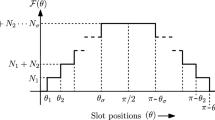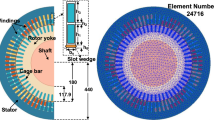Abstract
The elimination of harmonic components of the magnetic motive force (MMF) waveform improves the performance of induction motors. The non-sinusoidal MMF waveform creates harmonic components. One of the effects of these components is to increase core losses, noise, and vibration while reducing the efficiency of induction motors. In this paper, to eliminate the harmonic components of the MMF waveform, a novel winding design for the stator of the induction motors is presented. Then, the novel winding design is compared to the conventional one. The effects of the new winding have been investigated to improve the performance of the induction motor. Also, the designed stator winding in ANSYS MAXWELL software was simulated and its magnetic parameters were evaluated. Finally, practical experiments have been performed on two similar 3-phase motors of 380 V, 50 Hz, 180 W, and 2-pole. The obtained simulation and experimental results illustrate the superiority of the novel winding over the conventional one.













Similar content being viewed by others
Data availability
The data that support the findings of this study are available from the corresponding author upon reasonable request.
References
Asad B, Vaimann T, Belahcen A, Kallaste A, Rassõlkin A, Iqbal MN (2020) Modified winding function-based model of squirrel cage induction motor for fault diagnostics. IET Electr Power Appl 14(9):1722–1734
Kutt F, Michna M, Kostro G, Ronkowski M (2017) Modelling of steady state and transient performance of the synchronous generator considering harmonic distortions caused by non-uniform saturation of the pole shoe. Electr Power Syst Res 143:409–414
Dale ME, Sullivan CR (2006) Comparison of single-layer and multi-layer windings with physical constraints or strong harmonics. In: 2006 IEEE International Symposium on Industrial Electronics, vol 2, pp 1467–1473
Camargos PH, Caetano RE (2021) A performance study of a high-torque induction motor designed for light electric vehicles applications. Electr Eng. https://doi.org/10.1007/s00202-021-01331-4
Khelfi H, Hamdani S (2020) Induction motor rotor fault diagnosis using three-phase current intersection signal. Electr Eng 102(2):539–548
Di Tommaso AO, Genduso F, Miceli R (2013) A software for the evaluation of winding factor harmonic distribution in high efficiency electrical motors and generators. In: 8th international conference and Exhibition on Ecological Vehicles and Renewable Energies (EVER). IEEE, pp 1–6
Zhu Y, Weisong Gu, Ke Lu, Zhihong Wu, Guan J, Chen Li (2020) Current harmonic elimination method for asymmetric dual three-phase permanent magnet synchronous motor. IET Electr Power Appl 14(10):1795–1806
Asgharpour-Alamdari H, Alinejad-Beromi Y, Yaghobi H (2017) Reduction in distortion of the synchronous generator voltage waveform using a new winding pattern. IET Electr Power Appl 11(2):233–241
Asgharpour-Alamdari H, Alinejad-Beromi Y, Yaghobi H (2017) Improvement of induction motor operation using a new winding scheme for reduction of the magnetomotive force distortion. IET Electr Power Appl 12(3):323–331
Gundogdu T, Komurgoz G (2013) Implementation of fractional slot concentrated winding technique to large salient-pole synchronous generators & development with permanent magnets. Electr Power Syst Res 105:57–70
Azzoug Y, Sahraoui M, Pusca R, Ameid T, Romary R, Marques Cardoso AJ (2021) Current sensors fault detection and tolerant control strategy for three-phase induction motor drives. Electr Eng 103(2):881–898
Reddy PB, Huh K-K, El-Refaie AM (2014) Generalized approach of stator shifting in interior permanent-magnet machines equipped with fractional-slot concentrated windings. IEEE Trans Ind Electron 61(9):5035–5046
Yokoi Y, Higuchi T, Miyamoto Y (2016) General formulation of winding factor for fractional-slot concentrated winding design. IET Electr Power Appl 10(4):231–239
Lai H, Lin W, Pu G (2020) Harmonic loss analysis of three-phase induction motor sine winding. In: 2020 IEEE International Conference on Artificial Intelligence and Computer Applications (ICAICA). IEEE, pp 1112–1115
Li ZC, Bao XH, Xu W, Liu YW (2018) Analysis of vibration and noise of single and double layer low harmonic winding induction motors. Micromotor 51(10):17–31
Tsujikawa K, Tokumasu T, Kakiuchi M et al (2012) Special winding to reduce space flux harmonics caused by fractional-slot. In: 15th International Conference on Electrical Machines and Systems (ICEMS), pp 1–6
Joksimovic G (2011) A.C. winding analysis using a winding function approach. Int J Electr Eng Educ 48(2):34–52
Birbir Y, Selcuk Nogay H (2007) Voltage and current harmonic variations in three-phase induction motors with different stator coil pitches. Int J Energy 1(4)
Wakileh GJ (2003) Harmonics in rotating machines. Electr Power Syst Res 66(1):31–37
Cai M, Henke M, Canders W-R (2014) An improved method for design of symmetrical multiphase winding with optimal space harmonics spectrum. In: 2014 17th International Conference on Electrical Machines and Systems (ICEMS). IEEE, pp 3469–3475
Tang N, Brown IP (2018) Framework and solution techniques for suppressing electric machine winding MMF space harmonics by varying slot distribution and coil turns. IEEE Trans Magn 54(5):1–12
Scuiller F (2020) A general, compact and easy-to-compute winding factor formulation. IET Electr Power Appl 14:1430–1437
Alteheld C, Hartmann AK, Gottkehaskamp R (2016) A new systematic method to design windings of polyphase rotating electrical machines and evaluation of their optimization potential. In: 2016 XXII International Conference on Electrical Machines (ICEM). IEEE, pp 1257–1263
Caruso M, Di Tommaso AO, Marignetti F, Miceli R, Galluzzo GR (2018) A general mathematical formulation for winding layout arrangement of electrical machines. Energies 11(2):446
Tommaso Di, Oscar A, Genduso F, Miceli R (2015) A new software tool for design, optimization, and complete analysis of rotating electrical machines windings. IEEE Trans Magn 51(4):1–10
Makita S, Ito Y, Aoyama T, Doki S (2014) The proposal of a new motor which has a high winding factor and a high slot fill factor. In: 2014 International Power Electronics Conference (IPEC-Hiroshima 2014-ECCE ASIA). IEEE, pp 3823–3827
Li ZQ (2019) Application of sine winding technology in the design of explosion-proof motor products. Intern Combust Engines Accessories 5:197–198
Livadaru L, Simion A, Mihai A-M, Munteanu A, Lazăr F, Adam A (2014) New winding solution for the improvement of the three-phase induction motor performance. In: 2014 International Conference and Exposition on Electrical and Power Engineering (EPE). IEEE, pp 295–298
Kocabas DA (2009) Novel winding and core design for maximum reduction of harmonic magnetomotive force in AC motors. IEEE Trans Magn 45(2):735–746
Funding
None.
Author information
Authors and Affiliations
Corresponding author
Ethics declarations
Conflict of interest
The authors declare that they have no conflict of interest.
Additional information
Publisher's Note
Springer Nature remains neutral with regard to jurisdictional claims in published maps and institutional affiliations.
Rights and permissions
About this article
Cite this article
Asgharpour-Alamdari, H. Design of a novel distributed winding for improving performance of the induction motors. Electr Eng 104, 2911–2922 (2022). https://doi.org/10.1007/s00202-022-01516-5
Received:
Accepted:
Published:
Issue Date:
DOI: https://doi.org/10.1007/s00202-022-01516-5




